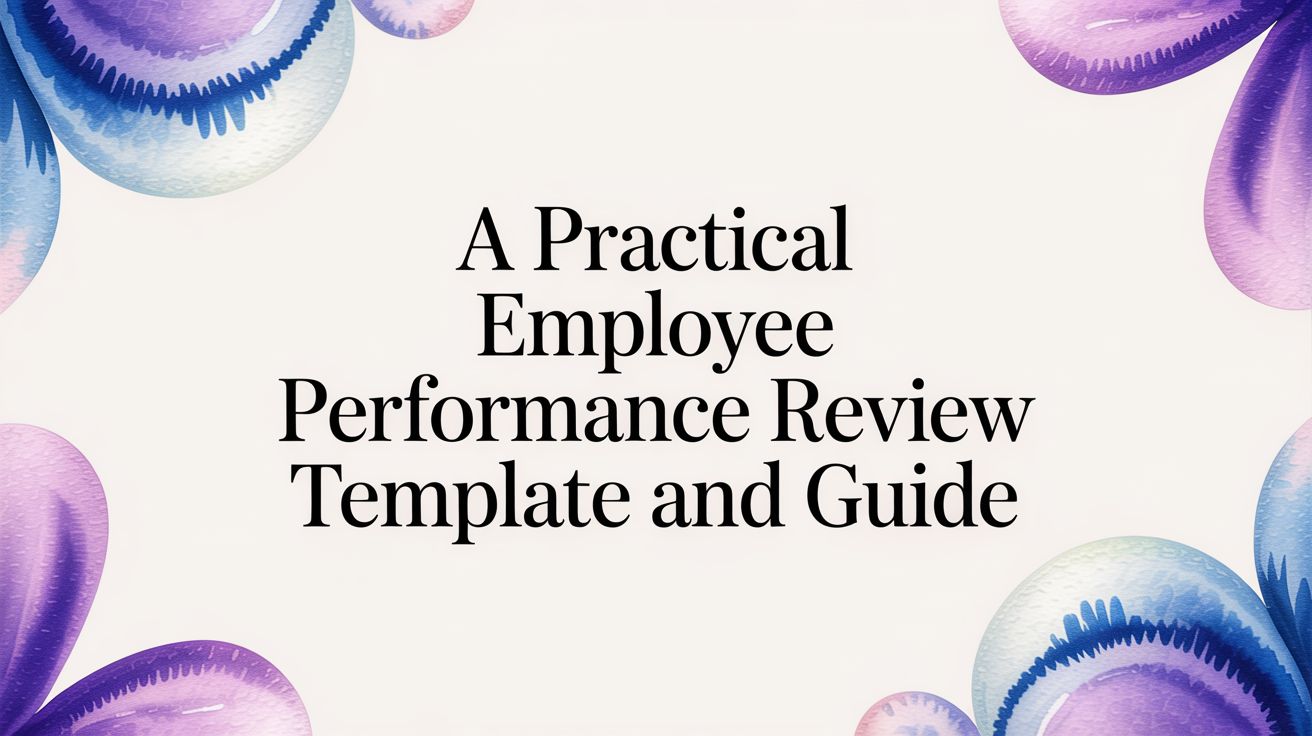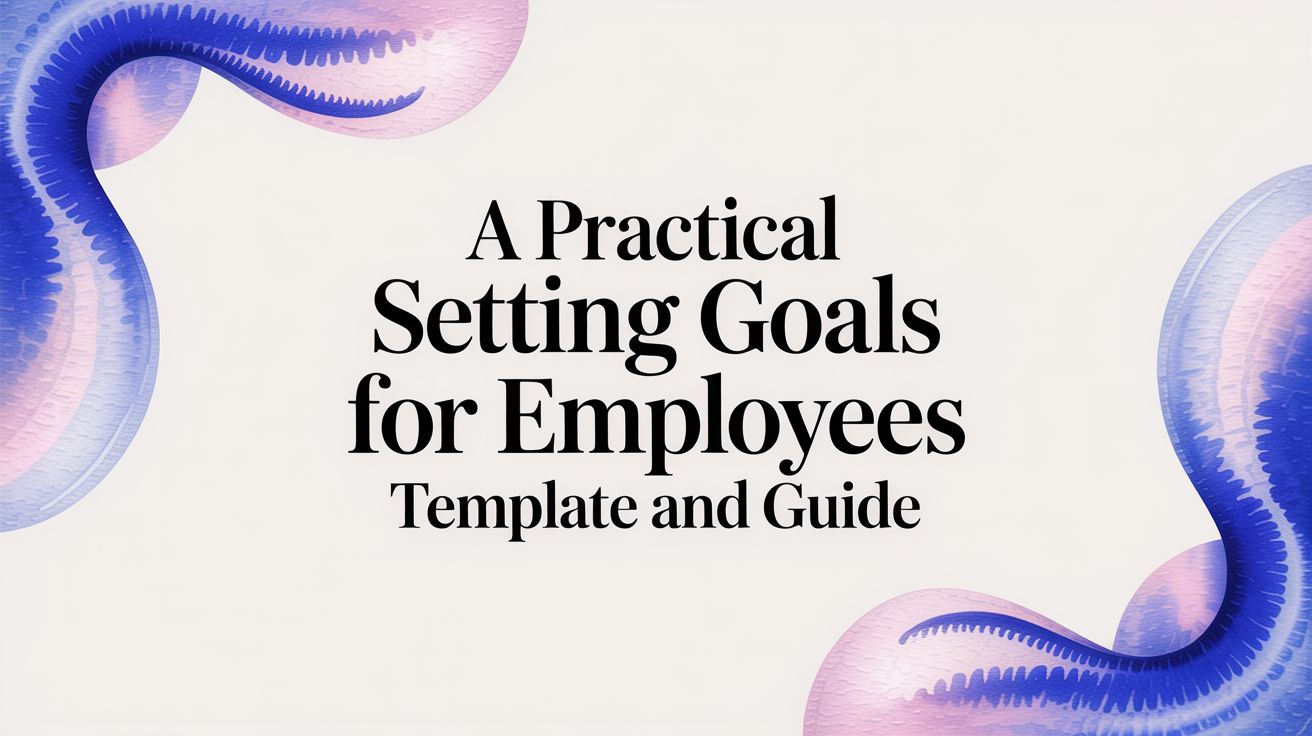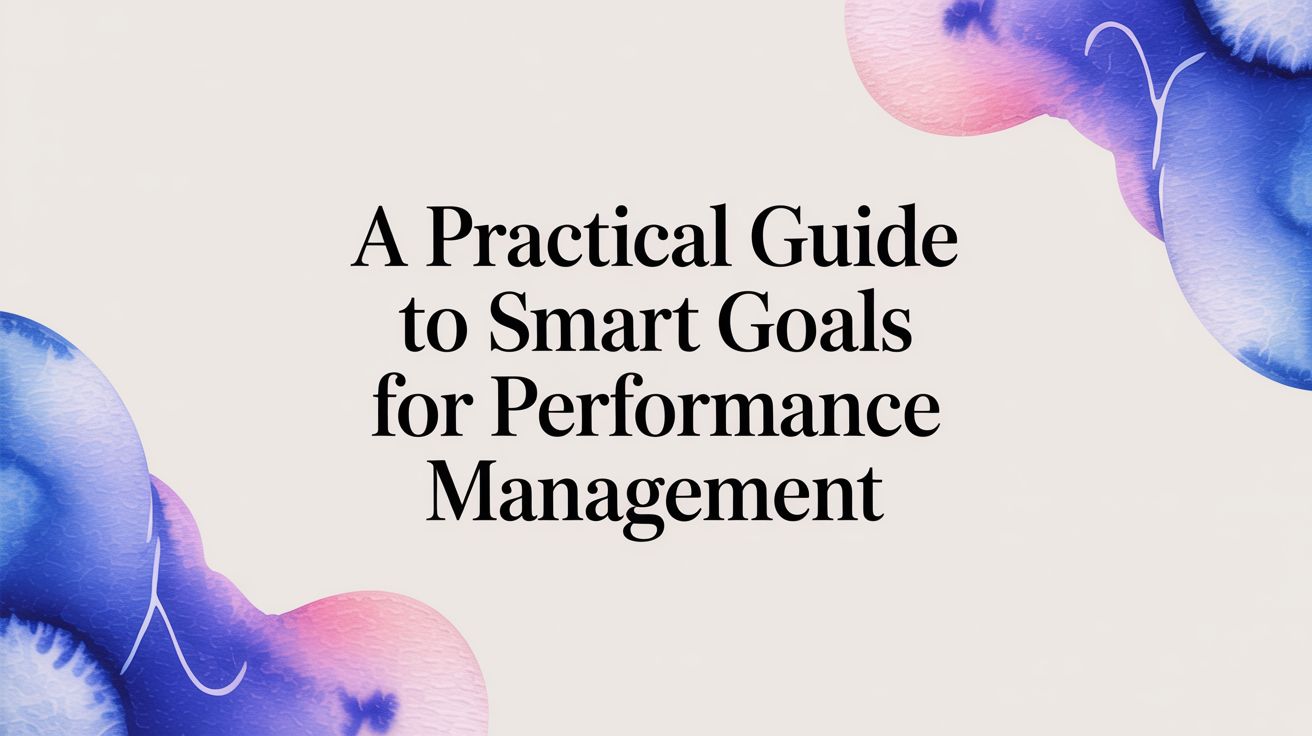A Manager's Guide on How to Give Feedback to Employees
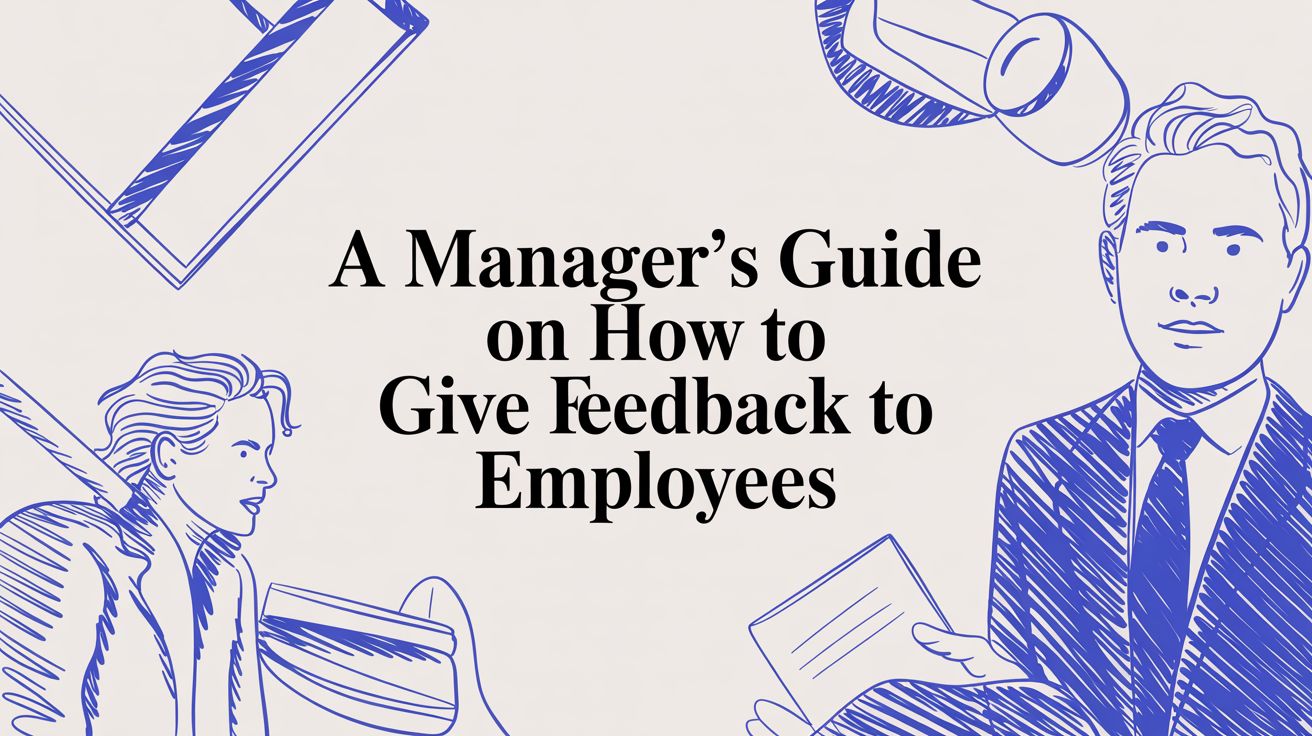
Giving feedback to your team is a crucial part of your job as a manager. It is not about pointing out mistakes or giving praise. When you do it right, feedback is a tool for growth. I found the best way to give feedback is with a simple, repeatable process. First, prepare with a clear goal. Second, deliver the feedback using a solid framework. Third, follow up with a concrete plan.
This process turns a stressful, awkward conversation into a routine part of helping your people improve.
Why Consistent Employee Feedback Is Essential for Growth

The annual performance review is dead. Or it should be. Waiting a whole year, or even a few months, to talk about performance is a missed opportunity. The most effective leaders I know have already moved on. They treat feedback as an ongoing conversation, not a once-a-year event.
When you give feedback regularly, you eliminate surprises. Your team members know where they stand and what is expected of them. This clarity cuts down on anxiety. It gives them the ability to make small adjustments along the way, rather than getting blindsided by old issues during a formal review.
The Impact of Frequent Communication
Creating a culture of continuous feedback does more than fix problems. It connects your team's day-to-day work to the company's bigger goals. When people get regular guidance, they feel more invested in what they are doing. That connection is a big motivator. Without it, employees feel like they are spinning their wheels.
Here is where many managers fall short. There is a huge perception gap. Many of us think we are giving feedback all the time, but our teams see it differently. Only 20% of employees say they get feedback weekly. Nearly half of all managers believe they are giving it that often.
This disconnect is a big deal. It means 32% of employees wait more than three months to hear how they are doing. That kind of silence kills morale. You can get a clearer picture if you look into more employee feedback statistics.
The numbers do not lie. 43% of highly engaged employees get feedback at least once a week. Compare that to 18% of employees with low engagement. The link is clear.
Benefits of a Structured Feedback Process
Putting a process in place for how to give feedback to employees is not about being more organized. It is about building trust. When people know what to expect, they feel safer. You create an environment where it is okay to talk about challenges as openly as you celebrate wins.
This guide gives you that structure. We will walk through how to:
- Prepare for conversations so they are productive.
- Deliver messages that are clear, specific, and actionable.
- Follow up effectively to make sure the feedback sticks.
By following these steps, you will stop being a critic and start being a coach. You will build a team that gets work done, and is resilient, aligned, and hungry to keep improving. Every conversation becomes a chance to get better, together.
How to Prepare for a Constructive Feedback Conversation
The best feedback conversations are won long before you sit down to talk. The difference between a conversation that builds someone up and one that creates confusion comes down to thoughtful preparation.
When you jump into a feedback session without a plan, you end up with vague comments that leave your employee wondering what you meant. Your goal is to walk in with a sharp focus, concrete examples, and a clear idea of what you want to achieve together.
Set a Single, Clear Objective
Every feedback conversation needs one primary goal. Just one. Are you there to recognize a job well done? Is this a course-correction on a performance issue? Are you discussing long-term career growth?
Trying to tackle all three at once is a recipe for a diluted message that will leave your employee feeling overwhelmed and unsure of the key takeaway. Decide on your main objective beforehand. This simple act keeps the conversation on track. If you have a few different things to discuss, it is often better to schedule separate, shorter check-ins for each topic.
Gather Specific, Factual Examples
Vague feedback is useless. Saying things like, “You need to be more proactive,” or “Great job on that project!” might feel like feedback, but it does not give anyone anything to work with. To be helpful, you must ground your comments in specific, observable behaviors.
Think back to the situations where you saw the employee either excel or struggle. Write down precisely what happened.
For instance, instead of, “You need to manage your time better,” try this: “On Tuesday, I noticed the Q3 report deadline was missed, and then the client proposal was late on Thursday. Can you walk me through what was going on?”
This approach shifts the conversation from a judgment of their character to a discussion about their actions and the results. Documenting these details also forces you to stay objective, which is critical if you need to learn more about how to have tough conversations with employees.
Organize Your Thoughts with a Simple Framework
A feedback model is not about being robotic. It is about being clear and consistent. It gives you a structure so your thoughts come out in a logical, helpful way. Two of the most effective frameworks are SBI and BOOST. You do not need to master both. Pick one that feels natural to you and start there.
- SBI (Situation, Behavior, Impact): This model guides you to describe the specific Situation, the person's observable Behavior, and the tangible Impact it had on the team, the project, or the business. It is a clean, fact-based approach.
- BOOST (Balanced, Objective, Observed, Specific, Timely): This one works like a pre-flight checklist. It reminds you to make sure your feedback is Balanced, rooted in Objective facts, based on something you personally Observed, highly Specific, and delivered in a Timely manner.
Using a framework like one of these helps strip the emotion and personal opinion out of the conversation. It keeps the focus on performance and business outcomes, which is where it should be.
Your goal is not to criticize, but to build awareness. When you prepare with facts and a clear structure, you turn a potentially difficult conversation into a collaborative problem-solving session.
Find the Right Time and Place
Finally, do not forget the logistics. This might seem small, but it has a huge impact on how your feedback is received.
Always deliver feedback in a private setting where you will not be interrupted. An open-plan office or a busy café is not the place for this, especially if the feedback is corrective. Even positive feedback lands better one-on-one, since not everyone loves being praised in public.
Timing is as important. Do not schedule a feedback session for 4:30 PM on a Friday or right before your employee heads out for a week-long vacation. Pick a time when you can both be present and focused, with enough buffer so no one feels rushed. Getting this right shows respect for your employee and signals that you value the conversation.
Choosing a Model to Structure Your Feedback
Have you ever walked into a feedback conversation and found yourself rambling? Or you start with a clear point, but the discussion gets sidetracked, and you leave feeling like you missed the mark. It happens. That is why having a simple model to structure your thoughts is so valuable.
Think of these frameworks as guardrails for your conversation. They do not script your words, but they do keep you on track. They turn abstract feelings into objective, specific points. When you stick to the facts, you lower the chances of the other person feeling attacked. This means they are more likely to listen and less likely to get defensive. This is the secret to giving feedback that works.
This decision tree shows how to match your preparation to your goal, whether you're giving praise, corrective guidance, or developmental advice.
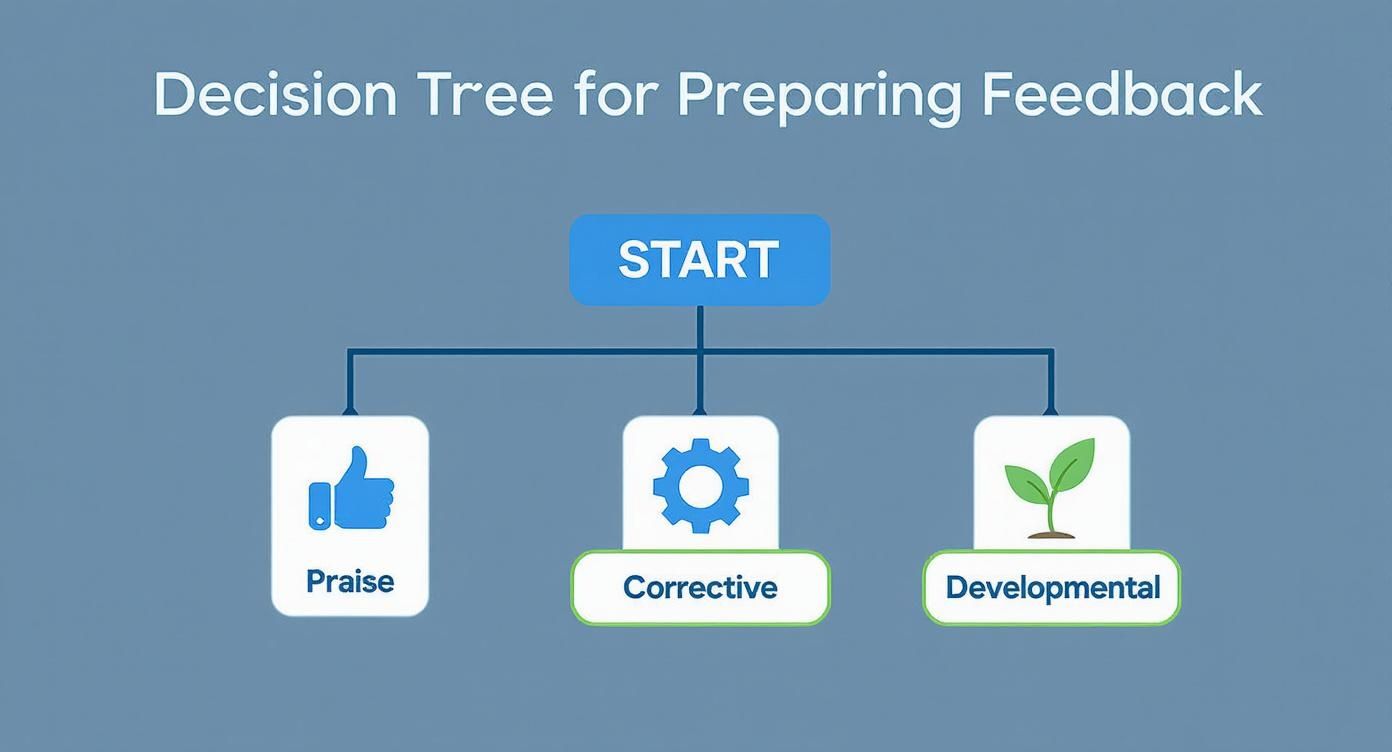
As you can see, the type of feedback you plan to give should shape the examples you gather and the approach you take. Let's look at two of the most effective models you can start using today.
The SBI Model: Situation, Behavior, Impact
For clear, direct, in-the-moment feedback, the SBI model is my go-to. It is straightforward and forces you to be specific by breaking your message into three simple parts. Its beauty is that it keeps the focus on the action, not the person.
Here is the breakdown:
- Situation: First, you set the scene. Pinpoint the specific "when" and "where" the event happened. This grounds the feedback in a shared reality, not a vague generalization.
- Behavior: Next, describe what the person did or said. This has to be observable and factual. Stick to what a video camera would have recorded. No judgment, no assumptions about their intent.
- Impact: Finally, connect the dots. Explain the result of their behavior. What was the effect on the team, the client, the project, or you?
Let’s say you need to address a confusing presentation. A vague approach like, “Your report was confusing,” is useless.
Instead, try SBI:
“During yesterday morning's team meeting (Situation), when you presented the Q3 performance data, I noticed several charts did not have clear labels (Behavior). The impact was that the team spent ten minutes asking for clarification instead of discussing next steps, which put us behind on making a decision.”
See the difference? It is specific, non-accusatory, and gives the employee a clear understanding of what to do differently next time.
The BOOST Model: A Pre-Flight Checklist
While SBI is a great script, the BOOST model is more like a pre-flight checklist. It is a tool you use before the conversation to make sure your feedback is ready. It pushes you to review your talking points against five key principles.
Run your planned feedback through this quality check:
- Balanced: Are you only showing up to point out flaws, or are you also recognizing strengths over time?
- Objective: Is this feedback based on solid facts, or is it clouded by your personal feelings and interpretations?
- Observed: Did you see or hear this yourself? Second-hand feedback is a recipe for disaster.
- Specific: Can you point to a concrete example, or are you talking in generalities?
- Timely: Are you giving the feedback soon after the event, while it's still relevant?
Let's say a team member did a brilliant job handling a difficult client call. Before you give them a high-five, you run it through BOOST. Your feedback is balanced (you're recognizing a clear strength), objective (it's about how they de-escalated the call), observed (you listened in), specific (you can name the client and the key turning point), and timely (you're pulling them aside the same day).
This quick check ensures your praise is not a generic "good job," but a reinforcement of the exact behaviors you want to see again.
Comparing SBI and BOOST Feedback Models
Choosing between these two models often comes down to the situation. SBI is perfect for delivering structured feedback on the fly. BOOST is a great preparation tool to ensure your message is sound, especially for more formal or sensitive conversations.
| Feature | SBI (Situation-Behavior-Impact) | BOOST (Balanced-Objective-Observed-Specific-Timely) |
|---|---|---|
| Primary Use | A script or structure for delivering feedback in conversation. | A checklist to prepare and quality-check feedback beforehand. |
| Best For | On-the-spot corrective or positive feedback. | Planned feedback sessions, performance reviews, sensitive topics. |
| Focus | Clearly linking a specific action to its outcome. | Ensuring the overall quality and fairness of the feedback. |
| Example Application | "In the meeting (S), you did X (B), and the result was Y (I)." | "Is my feedback on this project timely? Is it based on my own observation?" |
| Key Strength | Simplicity and directness. | Thoroughness and self-awareness for the manager. |
You do not have to choose one. Many of the best managers use BOOST to prepare their thoughts and then use the SBI framework to deliver the message clearly and concisely.
Delivering Positive and Corrective Feedback The Right Way
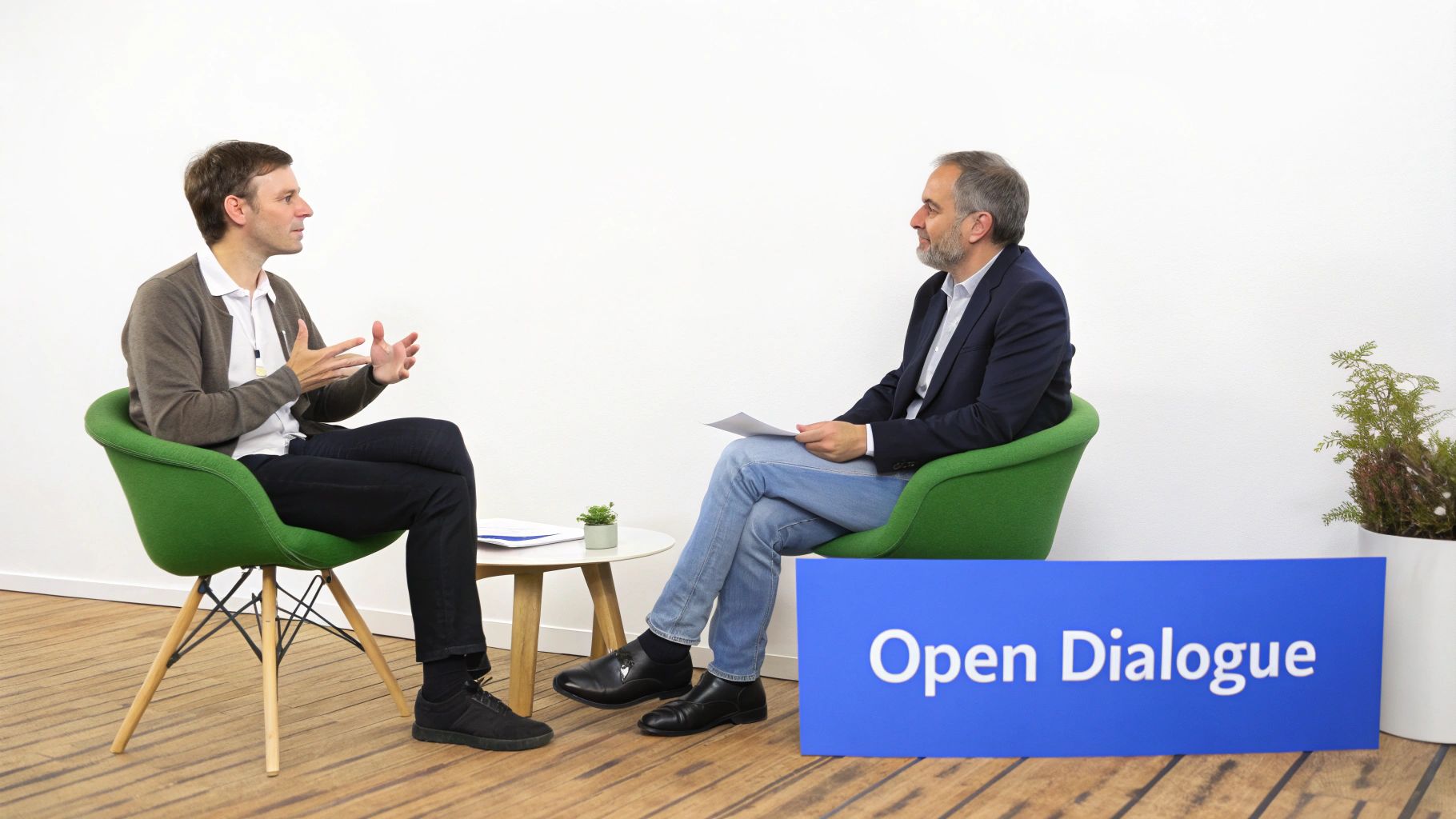
Here is a truth I learned the hard way: how you say something matters as much as what you say. When it comes to feedback, the right delivery can turn a one-way critique into a dialogue. Your real goal is to make them a partner in the conversation, creating a vibe where they feel heard and respected, even when the topic is a tough one.
It all starts with setting the right atmosphere. Find a calm, focused space. Your body language speaks volumes before you open your mouth. Sit in a neutral, open posture and maintain steady eye contact. These small signals tell them you're present and engaged, which makes it easier for them to open up.
Giving Positive Reinforcement
Let’s be clear: "Good job!" is nice, but it is not effective feedback. To make an impact, positive reinforcement needs to be specific and timely. You want to pinpoint the exact behaviors you hope to see again. The key is connecting their actions to a positive business outcome.
Here is a simple script for recognizing great work:
“Hi Alex, I wanted to talk about the client presentation you gave this morning. Your slides were clear, and you nailed the answers to their questions about our new pricing. Because you were so well-prepared, the client agreed to move forward with the proposal. That was excellent work.”
See the difference? This script is immediate and specific. It draws a straight line from Alex's preparation to a win for the company. It is worlds away from a generic compliment. To see more ways to frame your praise, check out our guide on essential management feedback examples.
Delivering Corrective Feedback
Tackling performance issues requires a balance of directness and support. You need to state the problem clearly. Using a framework like SBI is perfect for this. Then immediately pivot to a problem-solving discussion. This is not about assigning blame. It is about building awareness and finding a solution together.
Consider this script for addressing a missed deadline:
“Thanks for meeting with me. On Tuesday, the project update for the marketing team was due at noon, but it came through at 5 PM. The impact was that the team could not complete their part of the work, which has delayed the launch. Can you walk me through what happened?”
Notice how this kicks off with objective facts, not judgment. It then opens the floor with a question, inviting them to share their side of the story. This keeps the conversation focused on the issue, not the person.
Offering Developmental Guidance
Developmental feedback is about the future. This is where you shift from manager to coach, focusing on helping an employee build new skills and take the next step in their career. These conversations should feel forward-looking and motivational.
Here is how you could kick off a developmental chat:
“During our last few team projects, I have seen you do a fantastic job organizing tasks. I think you have a real strength for project coordination. Have you thought about taking on more of a leadership role on our next initiative? Let’s talk about what skills you would want to build to get there.”
This approach starts by highlighting a strength and connects it to a tangible future opportunity. It positions you as an ally who is invested in their long-term growth and success.
The effect of feedback is directly tied to how recent and meaningful it is. Research from Gallup found that 80% of employees who received meaningful feedback in the past week are fully engaged. That number plummets to 16% for those who did not feel their last conversation was meaningful. Timing and substance are everything.
Common Feedback Traps and How to Sidestep Them
Even well-intentioned managers can stumble into feedback traps that do more harm than good. Getting good at giving feedback often means unlearning a few common, but ineffective, habits. One small misstep can trigger confusion or defensiveness, completely derailing a productive conversation.
The Dreaded "Feedback Sandwich"
One of the most common mistakes is the feedback sandwich: praise, then criticism, then more praise. It feels kinder. Softer. But in reality, it muddies the water.
Your employee is more likely to hear the good stuff and miss the message you needed to deliver. Or worse, they start to distrust any praise you give, always waiting for the "but..." that follows.
Instead of softening the blow, the feedback sandwich creates confusion. If you have praise, give praise. If you have a correction, deliver the correction. Keep the two separate so both messages land with clarity.
Vague Language and Personal Jabs
Another major pitfall is feedback that is too fuzzy. Saying something like, “You need to show more attention to detail,” is useless. It does not give your employee anything specific to fix. You have to ground your feedback in observable behaviors and real-world examples.
Along the same lines, it is critical to focus on the performance, not the person.
- Bad: "You came across as arrogant in that client meeting."
- Good: "When you interrupted the client twice during the meeting, it made it difficult for them to finish their point."
See the difference? The first one feels like a personal attack, and the only natural response is to get defensive. The second example points to a specific, observable action and its impact. That opens the door for a real conversation about behavior, keeping things professional and focused on a path forward.
Mishandling Emotional Reactions
Defensiveness is a normal human reaction to criticism. When an employee gets emotional or pushes back, your first job is to stay calm and listen. Acknowledge what they are feeling without getting into an argument.
You can say something simple like, “I understand this is difficult to hear, and I appreciate you listening.” Then, gently bring the conversation back to the specific behaviors and their impact. If things get too heated and the conversation stops being productive, it is okay to hit pause and reschedule. Giving both of you some space to breathe can lead to a better outcome when you reconnect.
The "One and Done" Conversation
The final mistake is treating feedback as a one-time event. A feedback conversation should never be a fire-and-forget mission. You have to end the discussion with clear next steps and an agreement on when you will check in again.
This simple act of follow-up shows you are invested in their success. It transforms feedback from a single, dreaded event into an ongoing coaching relationship. That is how real growth happens.
Following Up to Drive Continuous Improvement
Giving the feedback is only half the job. It is the easier half. The real change, the kind that sticks, happens in the follow-up. This is where you transform a single conversation into a cycle of continuous improvement.
Without a clear plan for what comes next, even well-delivered feedback can evaporate, leaving you right back where you started.
Your immediate goal after the feedback conversation is to work together on a simple action plan. This is not a top-down directive. It is a shared roadmap that outlines the next steps, concrete goals, and a clear timeline for checking in.
Let's say the feedback was about improving presentation skills. The action plan might include watching a specific webinar on storytelling, practicing the next deck with a colleague, and taking the lead on a low-stakes section of the next team presentation. Simple. Actionable.
Creating an Actionable Plan
To make any plan stick, you first need to define what success looks like. What are the clear, measurable outcomes you can both agree on? This clarity is everything. It gives the employee a target to aim for and gives you a concrete way to track progress.
Once that is set, your role shifts from feedback-giver to supporter. This is where you build trust. Ask a simple question: "What do you need from me to succeed with this?"
Their answer is your guide. It will tell you how to help, whether it means connecting them with a mentor, approving a budget for a training course, or scheduling more frequent, informal check-ins.
If the situation is more serious and requires formal tracking, you can structure this process more rigorously. Our guide on how to write a performance improvement plan offers a complete walkthrough for handling more significant performance gaps.
A feedback conversation is a starting point, not a finish line. The follow-up is where you show your commitment to the employee's growth, building trust and proving that you are invested in their success.
Building a Continuous Feedback Culture
When you consistently follow up, you are doing more than managing one person's performance. You are reinforcing a culture where feedback is normal, ongoing, and always forward-looking.
Adopting these kinds of continuous performance management practices pays off. Research shows this approach is linked to a 14.9% lower turnover rate and can triple employee engagement. It is a tool for retention.
By making regular, informal check-ins the norm, you remove the pressure and anxiety that comes with infrequent, high-stakes formal reviews. This builds trust, elevates performance, and makes your entire team stronger.
Answering Your Top Questions About Employee Feedback
Even experienced managers run into tricky situations when it comes to feedback. Let's tackle a few of the questions I hear most often.
How Do I Give Feedback to a Remote Employee?
When your team is remote, always opt for a video call. It is the next best thing to being in the same room, letting you pick up on body language and non-verbal cues that are lost in text.
Whatever you do, resist the temptation to send significant corrective feedback over Slack or email. Your tone can be misinterpreted, turning a constructive point into a source of anxiety. Prepare your talking points like you would for an in-person chat, stick to a clear model like SBI, and have the conversation face-to-face.
What if an Employee Gets Defensive?
First, do not take it personally. Defensiveness is a human reaction when we feel criticized. The key is to stay calm and shift from talking to listening.
Let them have their say without interrupting. Acknowledging their feelings with something simple like, "I get that this can be tough to hear," can go a long way. It shows you are listening and you respect their perspective. Gently bring the focus back to the observable behavior and its impact, not their character.
Pro Tip: If the conversation starts going in circles or gets too heated, it is perfectly fine to hit the pause button. Say, "You know what, let's take a break from this and pick it up tomorrow morning." Giving both of you time to cool down is often the most productive move.
How Often Should I Give Feedback?
The short answer? More often than you think. The goal should be a culture of continuous feedback, not a series of stressful, high-stakes events.
Spot someone doing great work? Tell them right away. Notice something that needs correcting? Address it while the context is still fresh for both of you.
Regular, lightweight check-ins make feedback a normal, expected part of your working relationship. When it becomes routine, the anxiety melts away for both you and your team.
Ready to turn feedback prep from a chore into a confident conversation? PeakPerf gives you the guided workflows and proven frameworks you need to craft clear, professional feedback in minutes. Start building better leadership moments for free.

